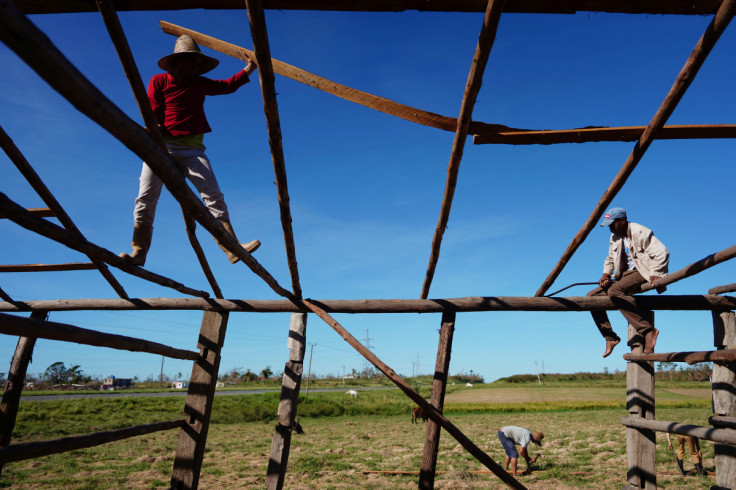Scavenging For Supplies, Cuba's Tobacco Farmers Rebuild After Hurricane Ian

When Hurricane Ian ripped through western Cuba last week, tobacco farmer Victoriano Maqueira lost the two large barns he used for drying his crop, as well as his dogs, chickens, a pig, his television and the roof off his home.
The deluge drenched his tobacco seeds, so he will not plant this year. But this was no time to sulk, the wiry 63-year old told Reuters, as he tilled his fields with oxen to plant beans instead.
"I wanted to cry, to scream," he said, recalling the moment he saw the damage to his home and barns. "We're going to lose an entire year. But you need to keep moving forward."
Cubans, renowned for their resiliency and ingenuity born of scarcity, began rebuilding early this week with supplies scavenged from the wreckage.
But recovering from the disaster represents a massive challenge in a poor country already suffering a grave economic crisis, said Cuban economist Omar Everleny.
A Cold War-era U.S. embargo and a tourism industry that still has not recovered from the effects of the coronavirus pandemic have combined to knee-cap Cuba's already inefficient state-run economy.
"The effects will be more severe than ever due to the pile-up of already existing difficulties," said Everleny.
The storm, which collapsed Cuba's entire electric grid, damaged 63,000 homes in hard-hit Pinar del Rio, including upwards of 7,000 the state has classified as a total loss. Less than a quarter of that province had power late this week.
Nearly all of its tobacco infrastructure - including drying houses - were flattened by the hurricane just days ahead of the October planting season.
Repairing that damage, Everleny said, will require spending money Cuba doesn't have on such things as fuel, cement, water tanks, cables and lumber - all materials in short supply even before the storm hit.
That will likely knock back the country's gross domestic product - initially predicted by officials to grow 4% in 2022, he added.
TOBACCO INDUSTRY HEART
Pinar del Rio is the heart of Cuba's tobacco industry, which drives $500 million in exports and employs thousands of the country's famous cigar rollers. The region produces 65% of Cuba's crop.
President Miguel Diaz-Canel has visited Pinar del Rio three times since Ian struck. Earlier this week he announced the state would underwrite 50% of the cost of rebuilding homes, and a caravan of lineworkers have been sent to the province to restore power.
"We are going to recover. You can be sure of that," Diaz-Canel told residents on his most recent visit. But he also urged patience, noting supplies would arrive "little by little."
State-run media this week said residents of some communities would receive rations of rice, beans and cooking oil to bridge the gap. TV footage showed some of the goods arriving in boxes stamped as donations from Russia.
Mexico and Venezuela have also donated supplies, officials said.
The Cuban government says the U.S. embargo is an impediment to recovery. The government and state-run media have repeatedly referenced a full-page ad, placed by activist group The People's Forum, which ran Sunday in the New York Times and called on the United States to lift sanctions on Cuba to help their "neighbor" rebuild.
"It is unconscionable at this critical hour to maintain the blockade and engage in collective punishment against an entire people," the ad reads.
The administration of U.S. President Joe Biden has said it is evaluating ways to help the "Cuban people" but relations with Havana have been icy since a crackdown on protesters who took part in anti-government rallies last year.
The blackouts again prompted protests in Havana but Pinar del Rio, a rural province known for its pro-government slant, saw no demonstrations.
Locals began the clean-up themselves, with many who Reuters spoke to saying they would not wait for state aid to arrive.
In the town of San Luis, Asbel Siles, who lost his roof to the hurricane, worked with neighbor Jose Luis Pacheco to shape a splintered wooden telephone pole to prop up his now wobbly pink-and-white home.
"I'm rebuilding on my own," said Siles, a tobacco industry employee now out of work. "I'll need to buy what was lost. It's the only way."
Pacheco said his friend's home would be as good as new within the week. He was less sure about the local economy.
"The province is starting from scratch," he said. "I'm worried we'll go two or three years with nothing."



© Copyright Thomson Reuters {{Year}}. All rights reserved.





















